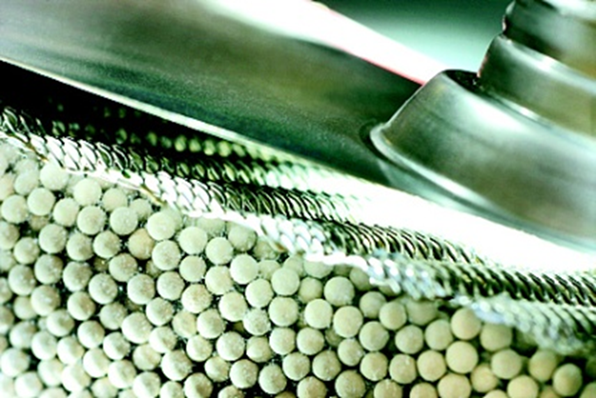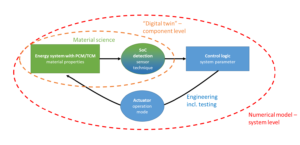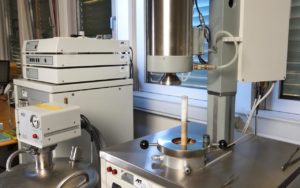IEA SHC Task 67: a worldwide effort in advancing compact thermal energy storage
April 14, 2025
Over the past three years, a distinguished team of 60 researchers from 14 different countries has collaborated intensively on advancing the characterization and optimization of compact thermal energy storage (CTES) materials and components. This international effort was led by Wim van Helden, Senior Researcher at the Austrian institute AEE INTEC, and took place under the auspices of the IEA Solar Heating and Cooling Programme. Van Helden took stock in the most recent IEA SHC Solar Academy webinar and gave an outlook on the issues to be worked on in the next planned CTES task. Among the remaining challenges are the scaling up of production technologies for thermal energy storage materials and investigating how to translate performance requirements into an optimal design of components. The photo shows Zeolite beads in a dishwasher, which is a market-established application for a thermochemical material. The recording and the presentation of the webinar are available online.
Photo: ZAE Bayern
Task 67 titled CTES materials within Components within Systems ended in September last year. The researchers are now working on a series of reports that will be published here in the coming weeks. One report features the standardized measurement procedures and round-robin tests, see also this news article. Another will describe the techniques used to determine the state of charge of TES materials.
From research to real-world solutions: state-of-charge determination
“Knowing the state of charge of a CTES is crucial for enabling active participation in the electricity grid, for example through power-to-heat applications”, explained van Helden during the webinar. “However, the temperature is not always a direct measure of the energy content of the material, especially if we have a lot of material in a container, for example with a bulk material.” Consequently, the Task 67 scientists developed a three-level model (figure 1).

Figure 1: Three-level model to determine the state of charge of compact thermal energy storages
Source: Technical University Denmark
The inner layer (green in the diagram) illustrates the measurement technique to create a material bulk response. The University of Applied Science in Upper Austria developed an indicative device whose signals report the water content of Zeolite beads, which is an indicator of the state-of-charge of the material.
In the second layer (orange) an external measurement of the storage system level is carried out. The example here comes from the Technical University of Denmark, where the heat flux into a vessel filled with phase-change material (PCM) is measured in order to have an idea of the total enthalpy incorporated into the system. “If we couple this with the model for the PCM inside the container, then we can calculate what the state of charge is at a given moment”, explained van Helden.
The Norwegian research institute SINTEF has worked on the blue level. In this case the PCM storage tank is part of an energy supply system and the state-of-charge measurements are used in order to optimally control the storage unit within the given system, using predictive control strategies.

Figure 2: Actions needed, as listed in the Technology Position Paper Source: Task 67
In addition, the Task 67 research group developed a concise five-page technology position paper, which outlines the current state of compact thermal energy storage (CTES), explores its potential across various applications and presents key recommendations for policymakers (see figure 2). You can download the paper here.
It is important to van Helden to name two challenges that he has repeatedly come across in his decades of work with CTES. First the “low industry involvement, which is normal, because there are no big markets at the moment”. This can only be overcome according to the task 67 manager if there is a targeted demonstration and market introduction support programme to avoid the so-called “valley of death”, which is blocking the development from TRL level seven to nine. The second challenge is the relatively high costs that should be addressed through long-term support programmes for market introduction, leading to cost reduction by economy of scale.
Kick-off meeting of next CTES task planned for October 2025
Under the leadership of van Helden, the research group has already thought about what goals they want to pursue in a further task on CTES. They want to submit the work programme to the Executive Committee of the IEA SHC Programme in June 2025 and then officially start work in July if possible. The kick-off meeting would then be in October 2025. Scientists and industry representatives from the CTES sector are, of course, welcome to attend. If you are interested, please contact Wim van Helden: w.vanhelden@aee.at
Websites of organizations mentioned in this news article:
IEA SHC Solar Academy webinars: https://www.iea-shc.org/solar-academy/webinars
IEA SHC Task 67 on Compact thermal energy storage materials within components within systems: https://task67.iea-shc.org/
IEA SHC Task 67 publications: https://task67.iea-shc.org/publications
AEE INTEC: https://www.aee-intec.at/
University of Applied Science in Upper Austria: https://fh-ooe.at/en
Technical University of Denmark: https://www.dtu.dk/english/
SINTEF: https://www.sintef.no/en/


